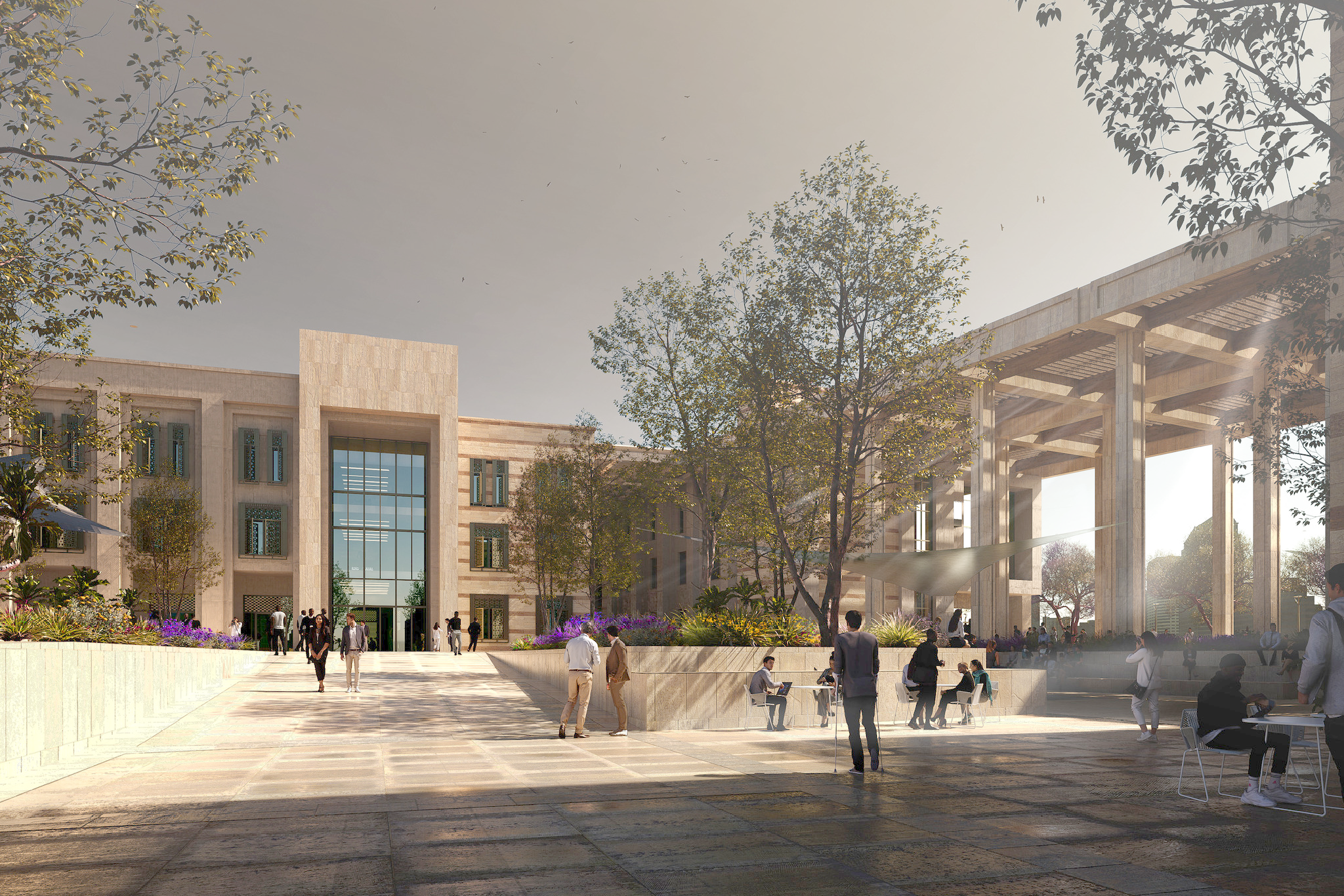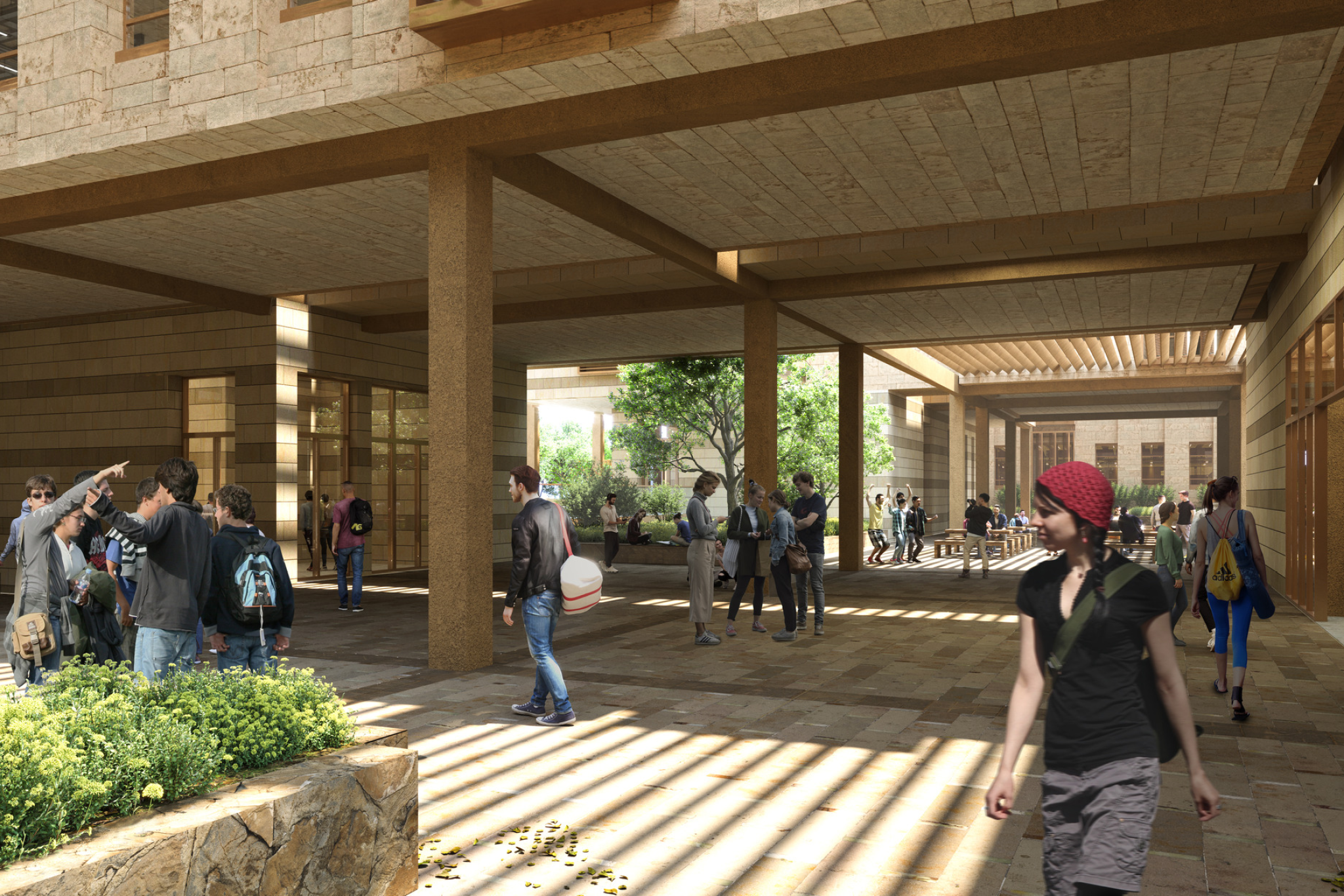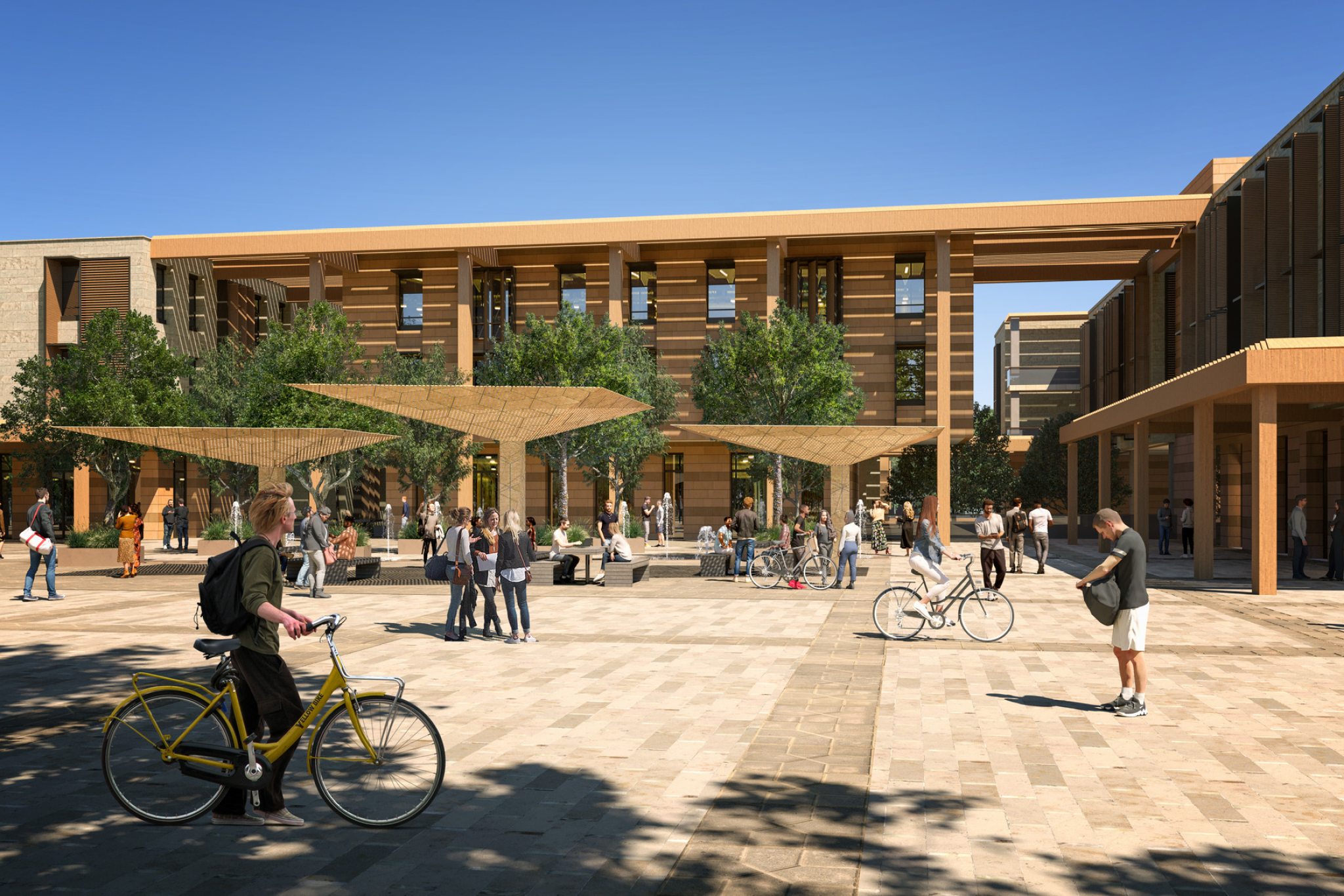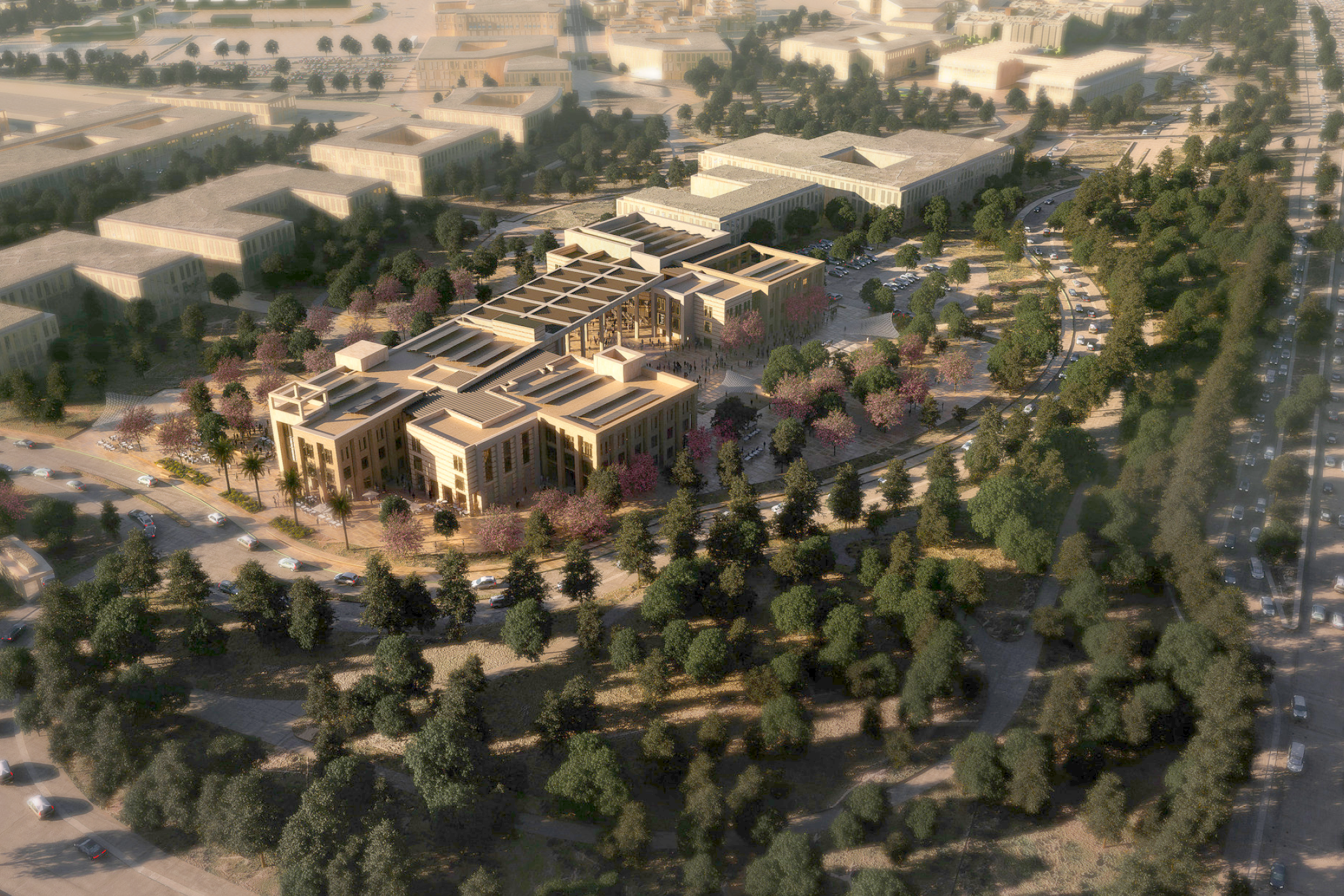In New Cairo, Egypt, The American University in Cairo (AUC) has broken ground on a roughly 270,000-sf expansion of its campus. The project encompasses two new buildings intended to enhance the physical campus and support AUC’s mission to provide top-tier education and research.
Designed by DLR Group, the AUC campus expansion project includes sustainable, state-of-the-art elements while preserving the character of the New Cairo campus.
The 146,970-sf Extended Education Hub offers classrooms, executive education areas, general spaces, and essential basement support spaces, in addition to rooftop gardens and a 450-seat auditorium. Featuring courtyards and landscaped pathways, the design aims to promote an interactive learning community, drawing inspiration from street bazaars and narrow alleys that open to larger, unexpected social spaces in Cairo.
The Extended Education Hub’s natural elements include a tranquil reflecting pool that provides evaporative cooling. Outside, trellises and canopies create designated areas for outdoor classrooms, gatherings, and leisure.
The 123,795-sf NextGen Student Living and Learning Spaces emphasize holistic student wellness and community building. It enables student connections via cafes, co-working spaces, prayer rooms, music rooms, and spacious living areas. Accommodating 300 beds, the project also features kitchens where students can cook and interact, as well as a garden-level basement. The residential interiors’ neutral palette allows students to express their personal identity through their furnishings, rugs, and art.
“Our design for two new buildings within the expanded AUC campus footprint fosters curiosity and innovative thinking within a cross-cultural environment,” Stu Rothenberger, DLR Group senior principal and global higher education leader, said in a statement. “Integrating sustainable design principles and supporting a stimulating learning environment that extends beyond the four walls of the classroom, this project will have a significant impact on the region and continue AUC’s inspiring legacy of elevating higher education in the world.”
Construction of the two university buildings is slated for completion by the end of 2026.
On the Building Team:
Owner: The American University in Cairo
Design architect: DLR Group
Architect of record, MEP engineer, and structural engineer: EHAF Consulting Engineers




Related Stories
| Dec 17, 2010
Alaskan village school gets a new home
Ayagina’ar Elitnaurvik, a new K-12 school serving the Lower Kuskikwim School District, is now open in Kongiganak, a remote Alaskan village of less than 400 residents. The 34,000-sf, 12-classroom facility replaces one that was threatened by river erosion.
| Dec 17, 2010
New engineering building goes for net-zero energy
A new $90 million, 250,000-sf classroom and laboratory facility with a 450-seat auditorium for the College of Electrical and Computer Engineering at the University of Illinois at Urbana/Champaign is aiming for LEED Platinum.
| Dec 17, 2010
How to Win More University Projects
University architects representing four prominent institutions of higher learning tell how your firm can get the inside track on major projects.
| Dec 6, 2010
Honeywell survey
Rising energy costs and a tough economic climate have forced the nation’s school districts to defer facility maintenance and delay construction projects, but they have also encouraged districts to pursue green initiatives, according to Honeywell’s second annual “School Energy and Environment Survey.”
| Nov 29, 2010
New Design Concepts for Elementary and Secondary Schools
Hard hit by the economy, new construction in the K-12 sector has slowed considerably over the past year. Yet innovation has continued, along with renovations and expansions. Today, Building Teams are showing a keener focus on sustainable design, as well as ways to improve indoor environmental quality (IEQ), daylighting, and low-maintenance finishes such as flooring.
| Nov 23, 2010
Honeywell's School Energy and Environment Survey: 68% of districts delayed or eliminated improvements because of economy
Results of Honeywell's second annual “School Energy and Environment Survey” reveal that almost 90% of school leaders see a direct link between the quality and performance of school facilities, and student achievement. However, districts face several obstacles when it comes to keeping their buildings up to date and well maintained. For example, 68% of school districts have either delayed or eliminated building improvements in response to the economic downturn.
| Nov 9, 2010
Just how green is that college campus?
The College Sustainability Report Card 2011 evaluated colleges and universities in the U.S. and Canada with the 300 largest endowments—plus 22 others that asked to be included in the GreenReportCard.org study—on nine categories, including climate change, energy use, green building, and investment priorities. More than half (56%) earned a B or better, but 6% got a D. Can you guess which is the greenest of these: UC San Diego, Dickinson College, University of Calgary, and Dartmouth? Hint: The Red Devil has turned green.
| Nov 3, 2010
First of three green labs opens at Iowa State University
Designed by ZGF Architects, in association with OPN Architects, the Biorenewable Research Laboratory on the Ames campus of Iowa State University is the first of three projects completed as part of the school’s Biorenewables Complex. The 71,800-sf LEED Gold project is one of three wings that will make up the 210,000-sf complex.
| Nov 3, 2010
Park’s green education center a lesson in sustainability
The new Cantigny Outdoor Education Center, located within the 500-acre Cantigny Park in Wheaton, Ill., earned LEED Silver. Designed by DLA Architects, the 3,100-sf multipurpose center will serve patrons of the park’s golf courses, museums, and display garden, one of the largest such gardens in the Midwest.
| Nov 3, 2010
Seattle University’s expanded library trying for LEED Gold
Pfeiffer Partners Architects, in collaboration with Mithun Architects, programmed, planned, and designed the $55 million renovation and expansion of Lemieux Library and McGoldrick Learning Commons at Seattle University. The LEED-Gold-designed facility’s green features include daylighting, sustainable and recycled materials, and a rain garden.














